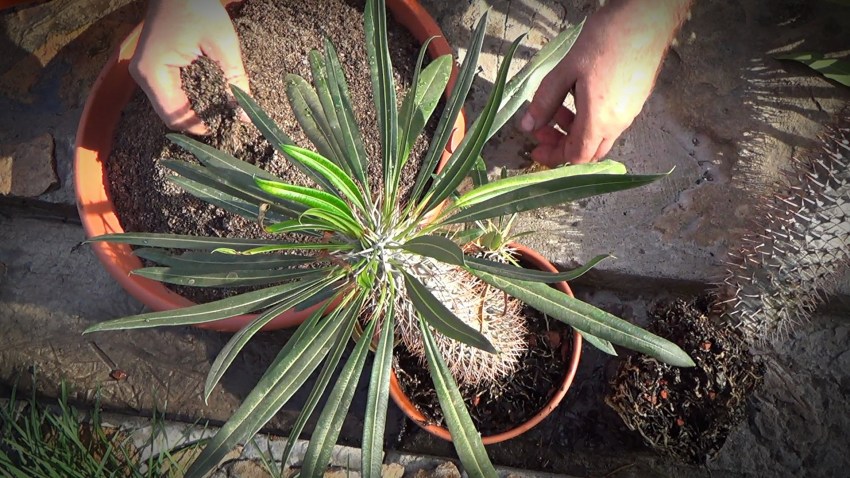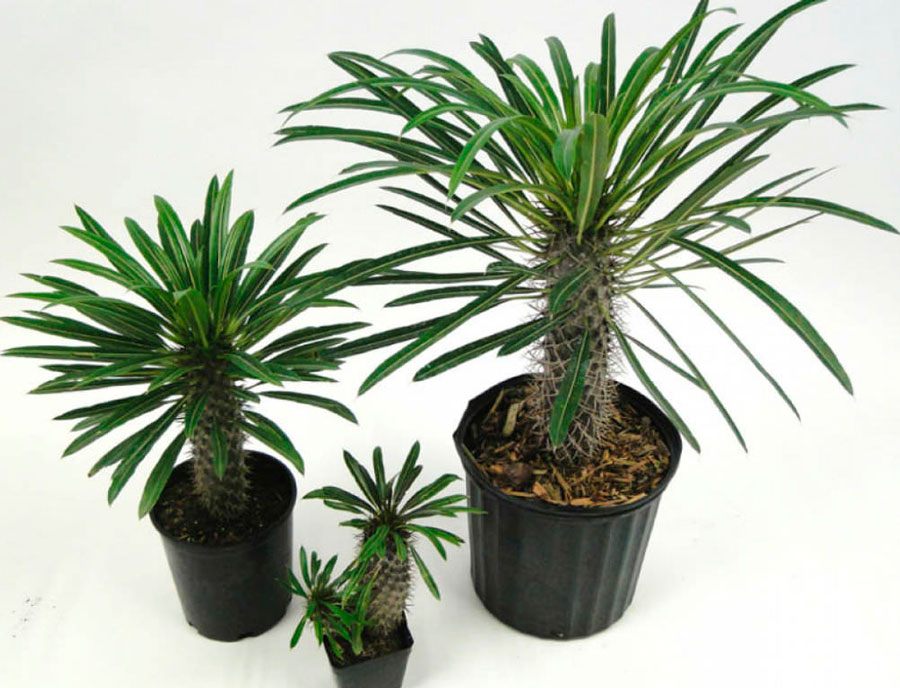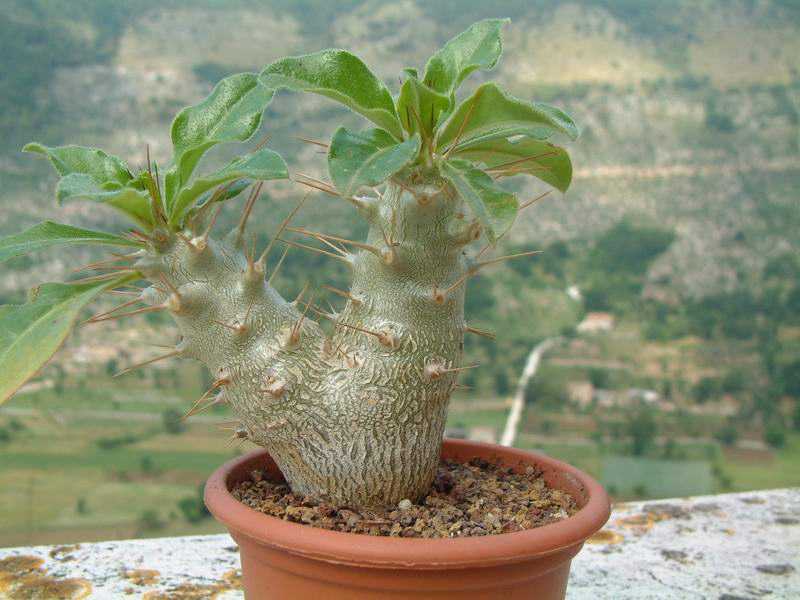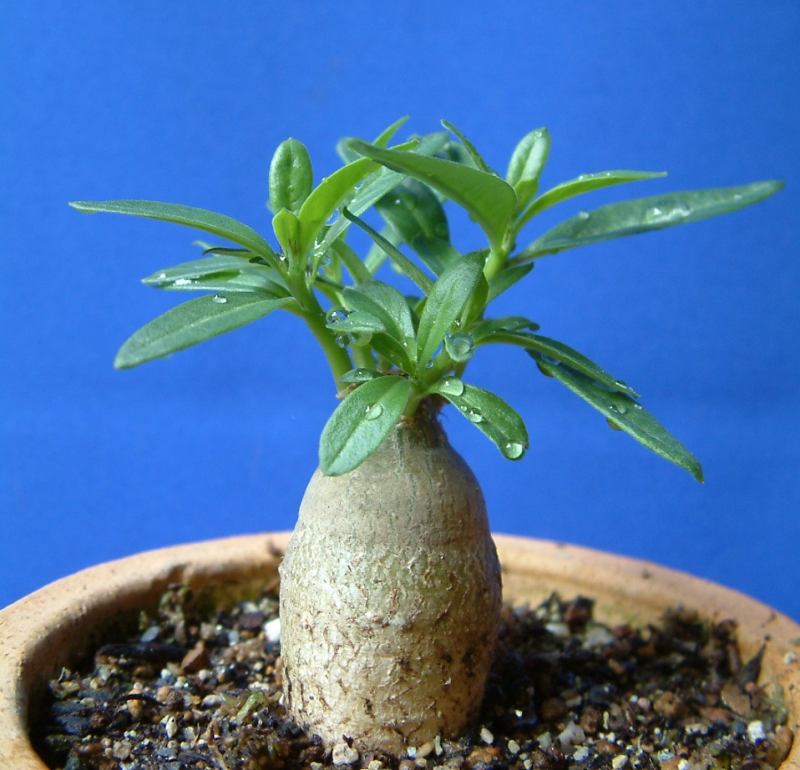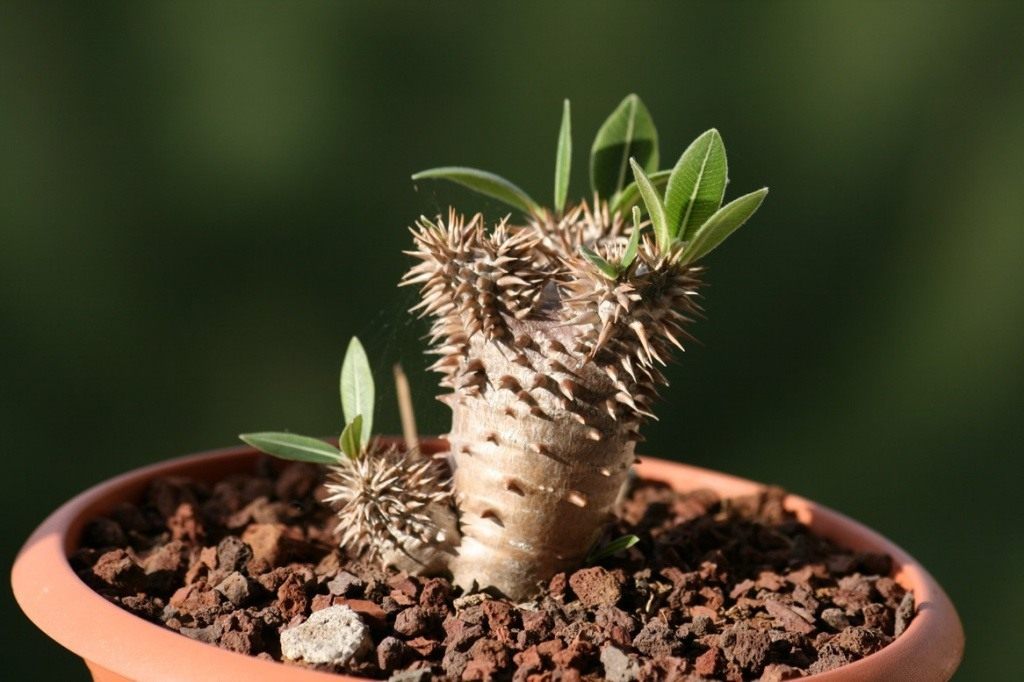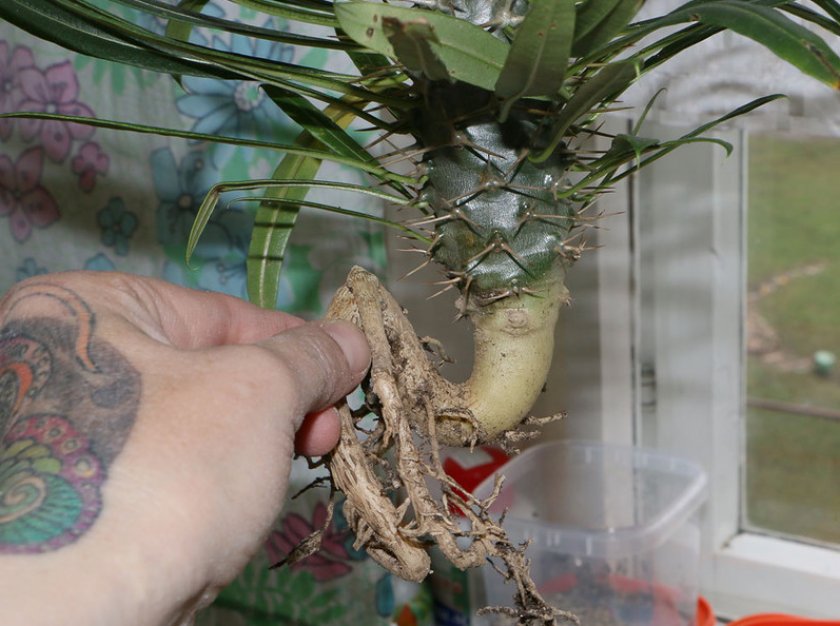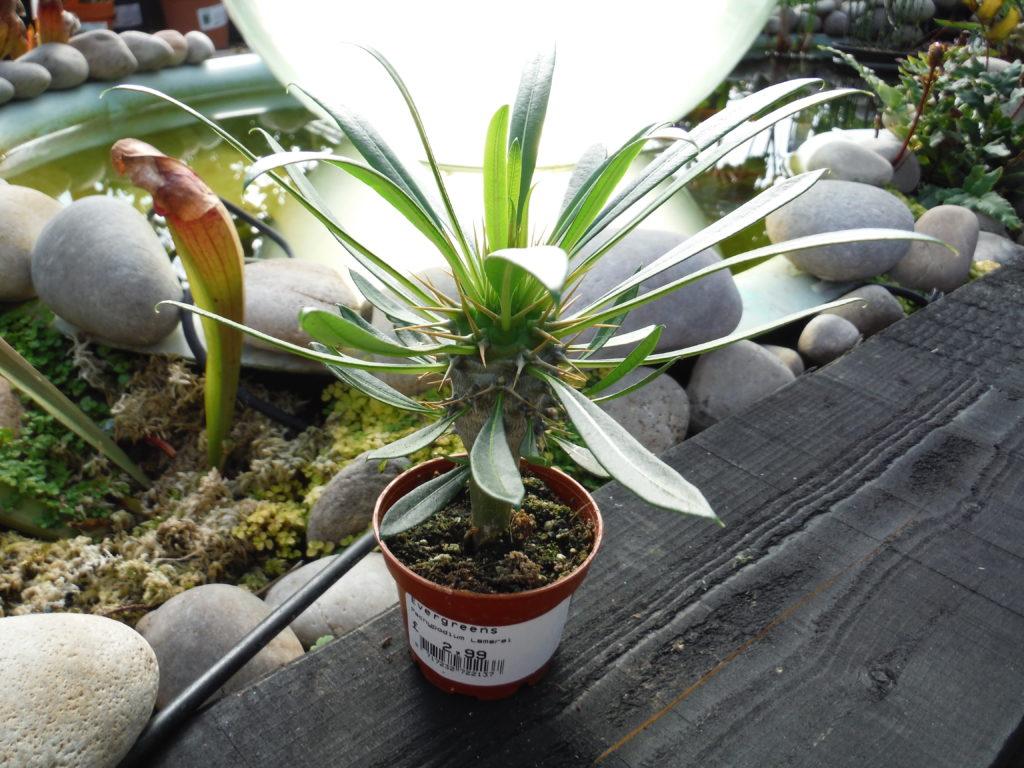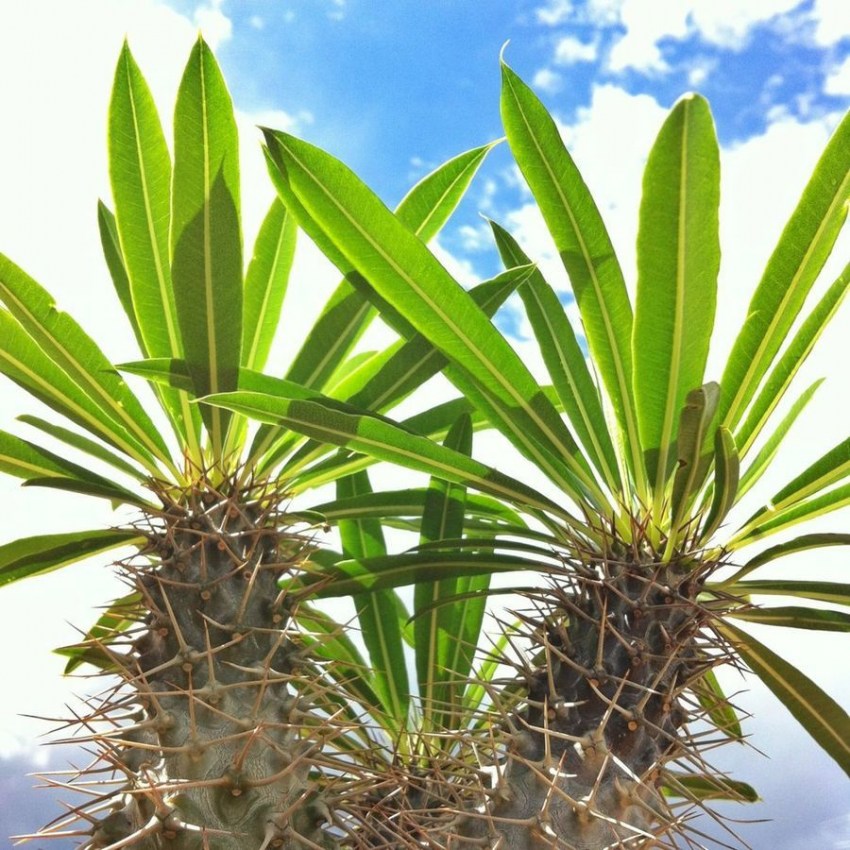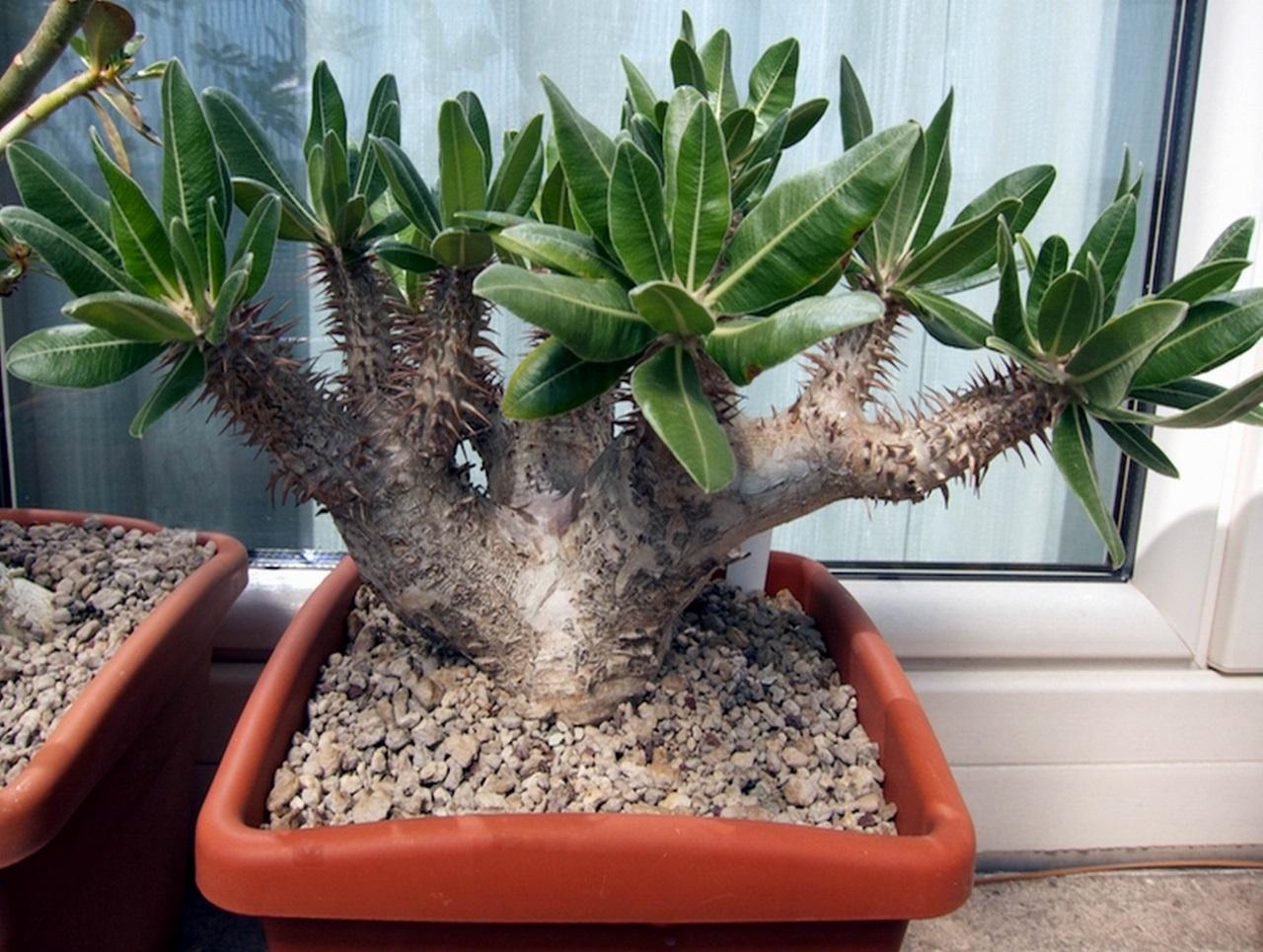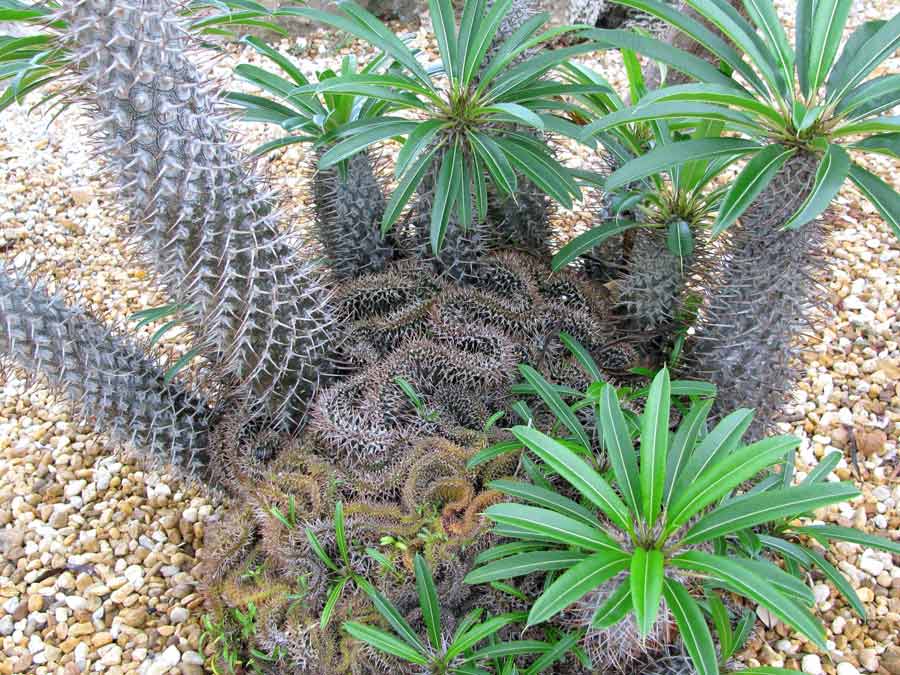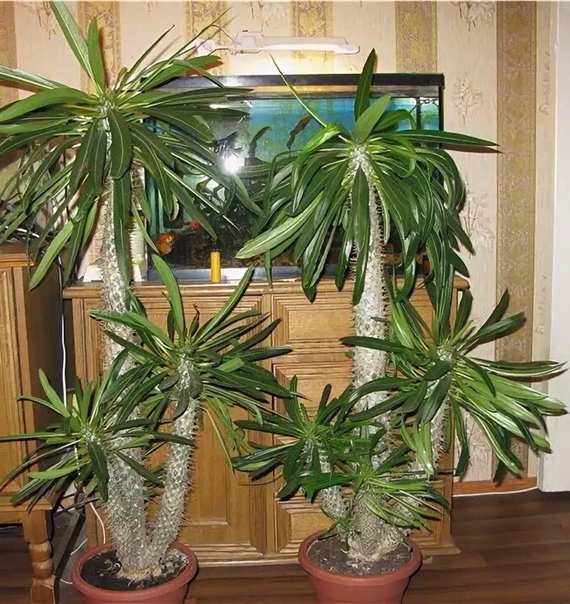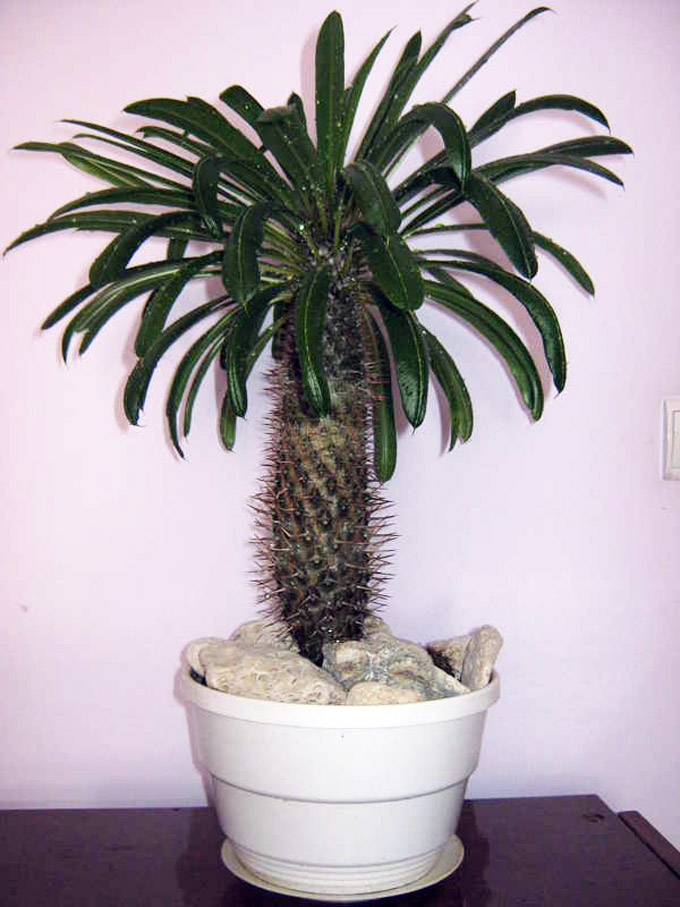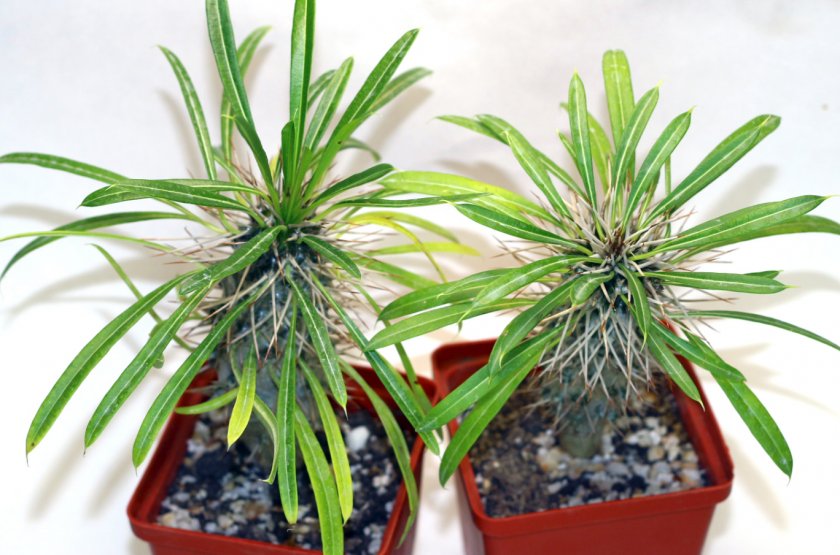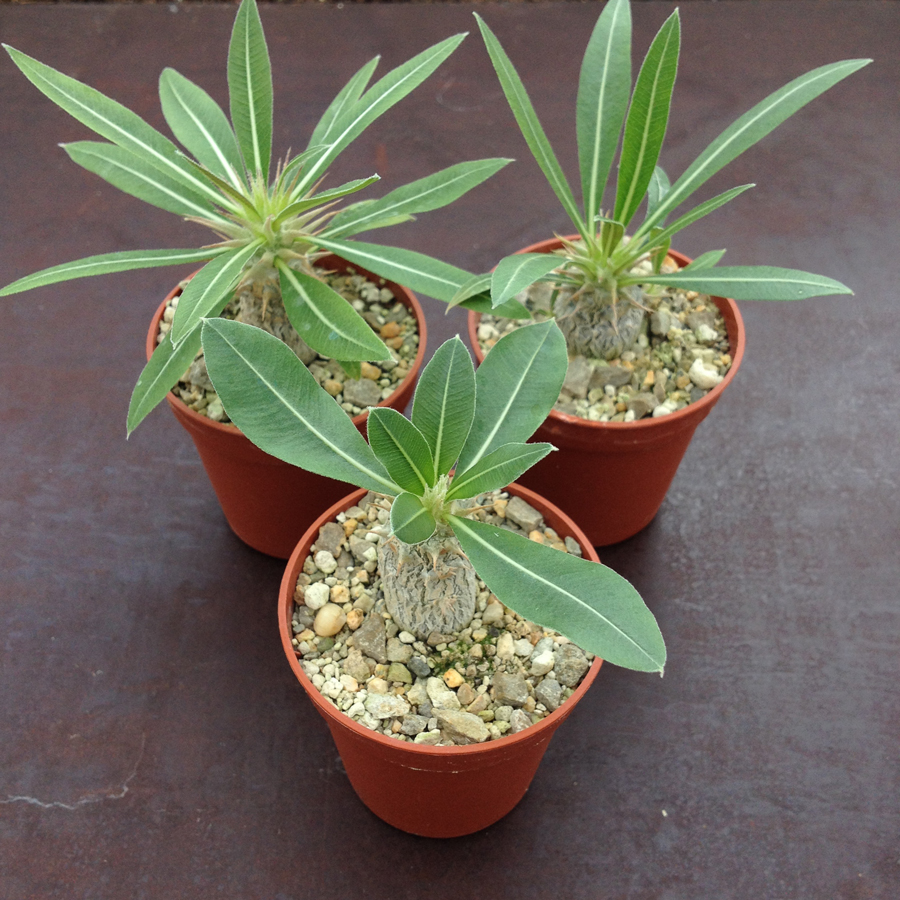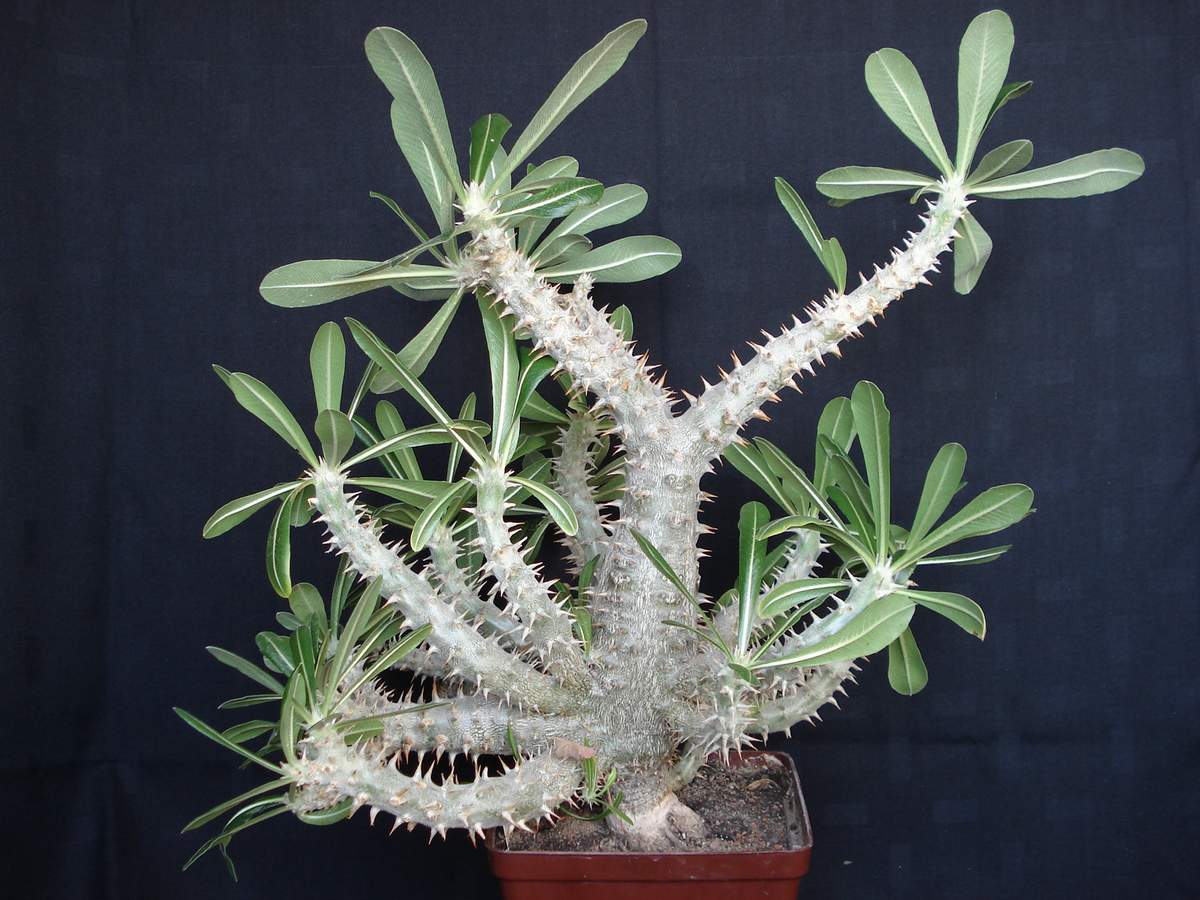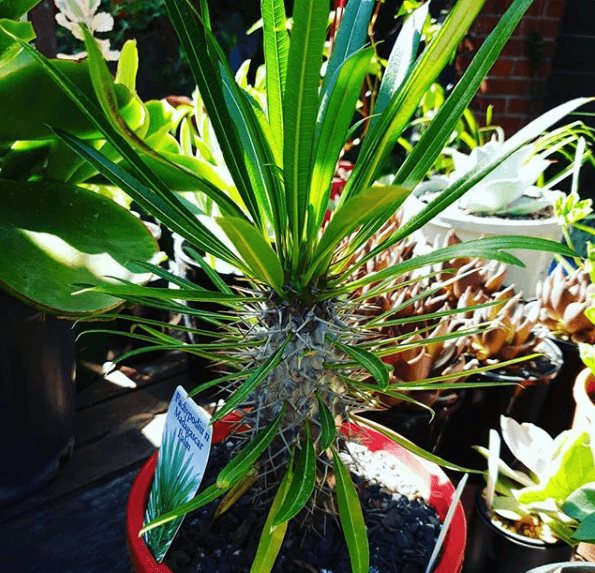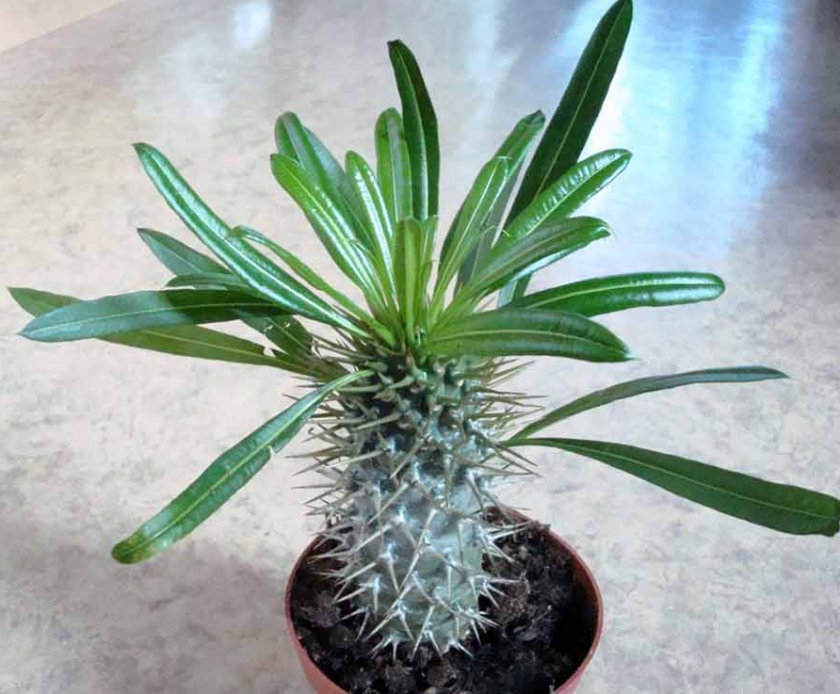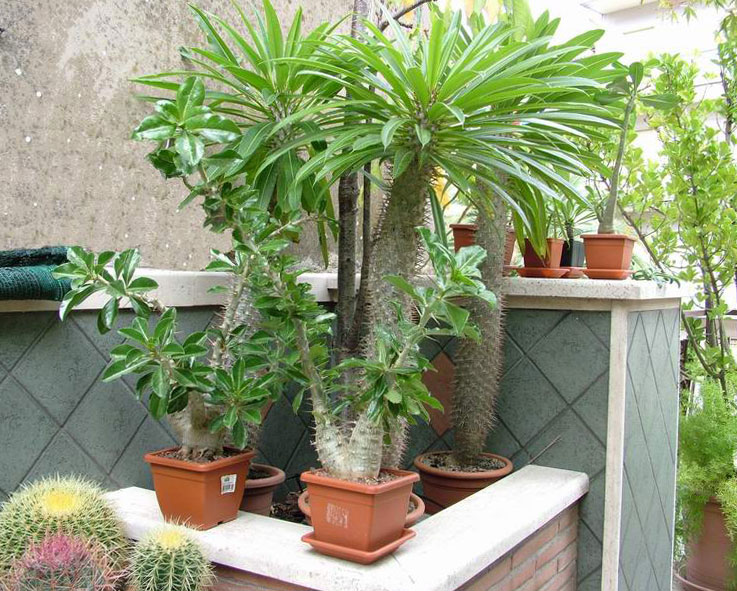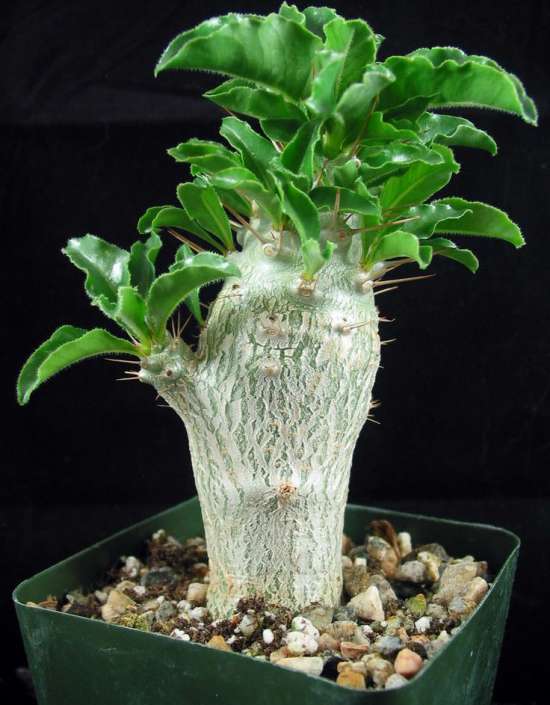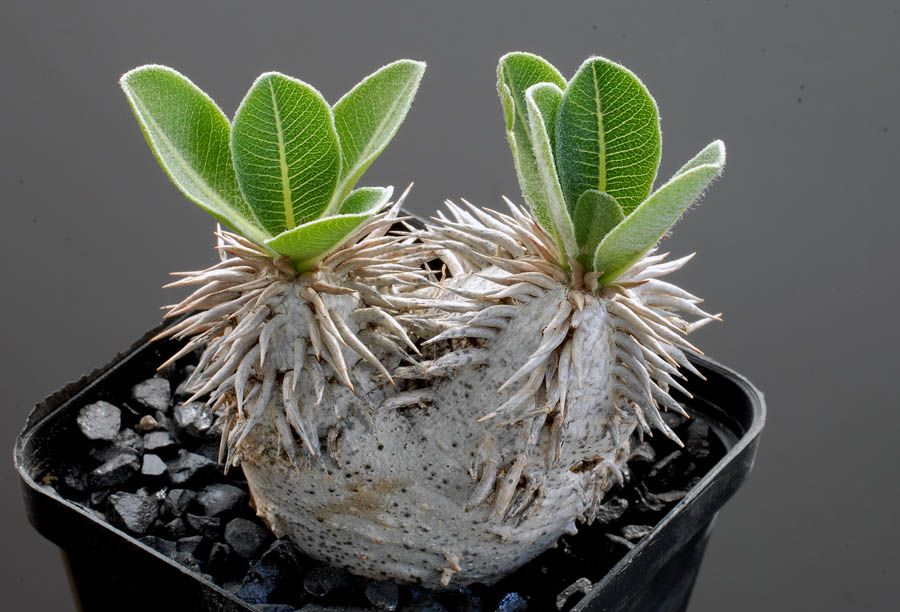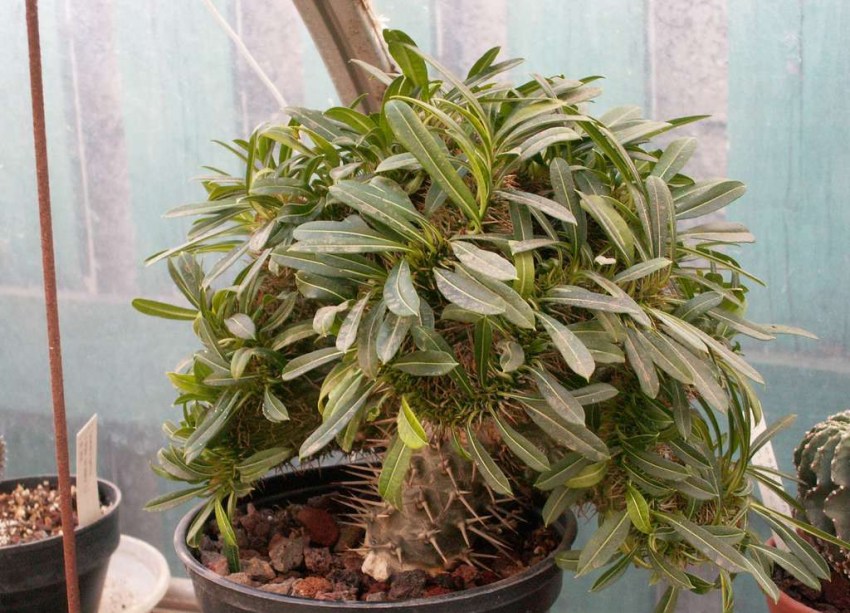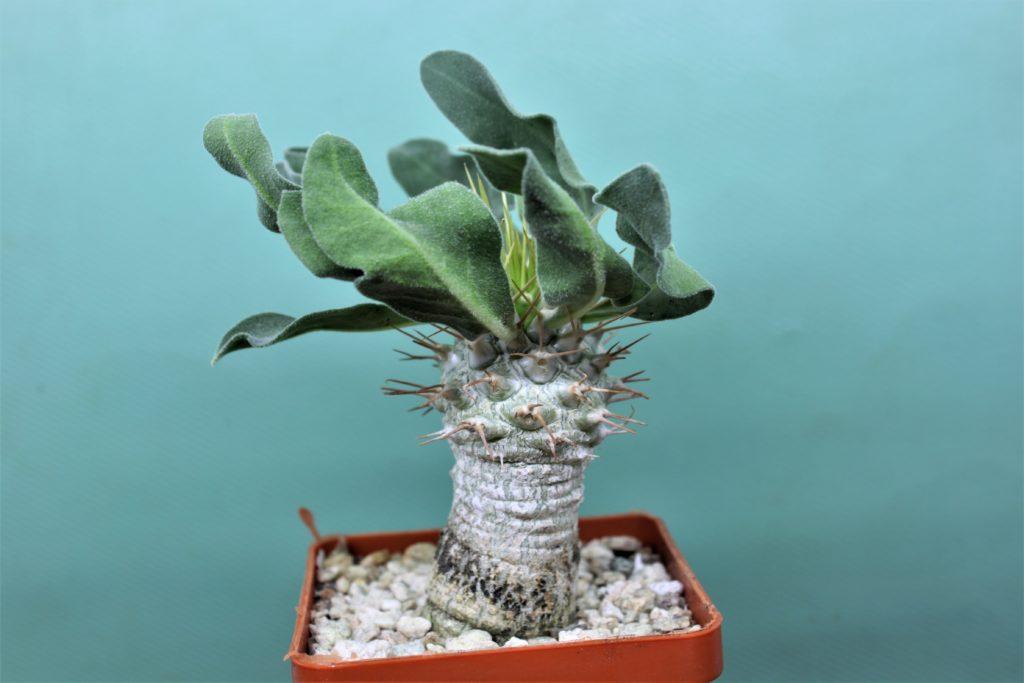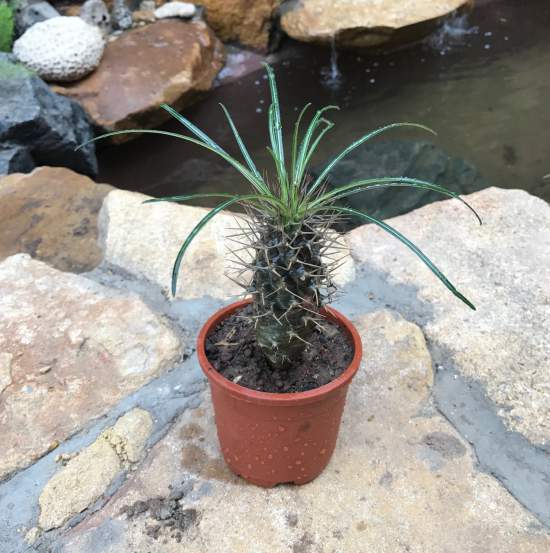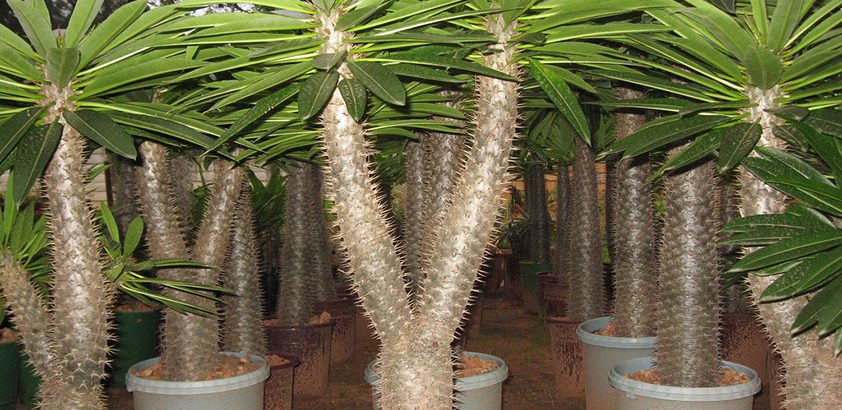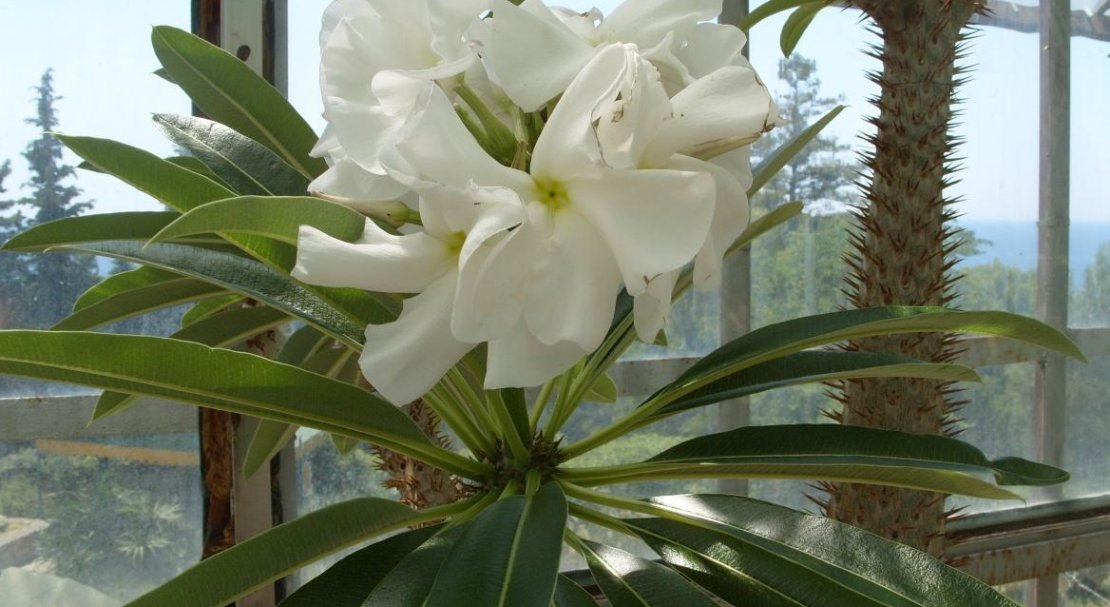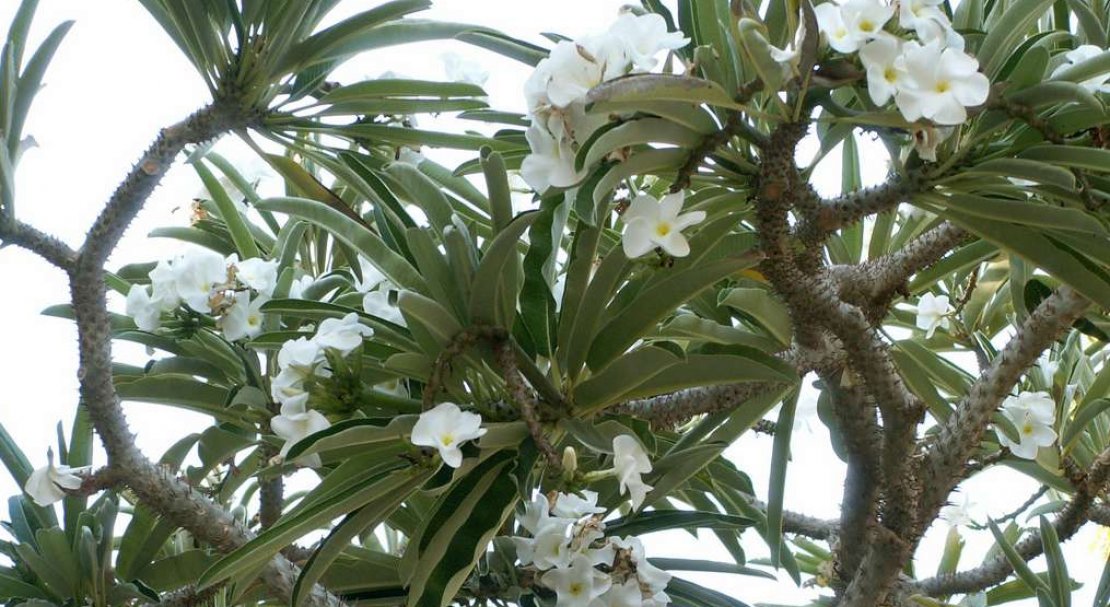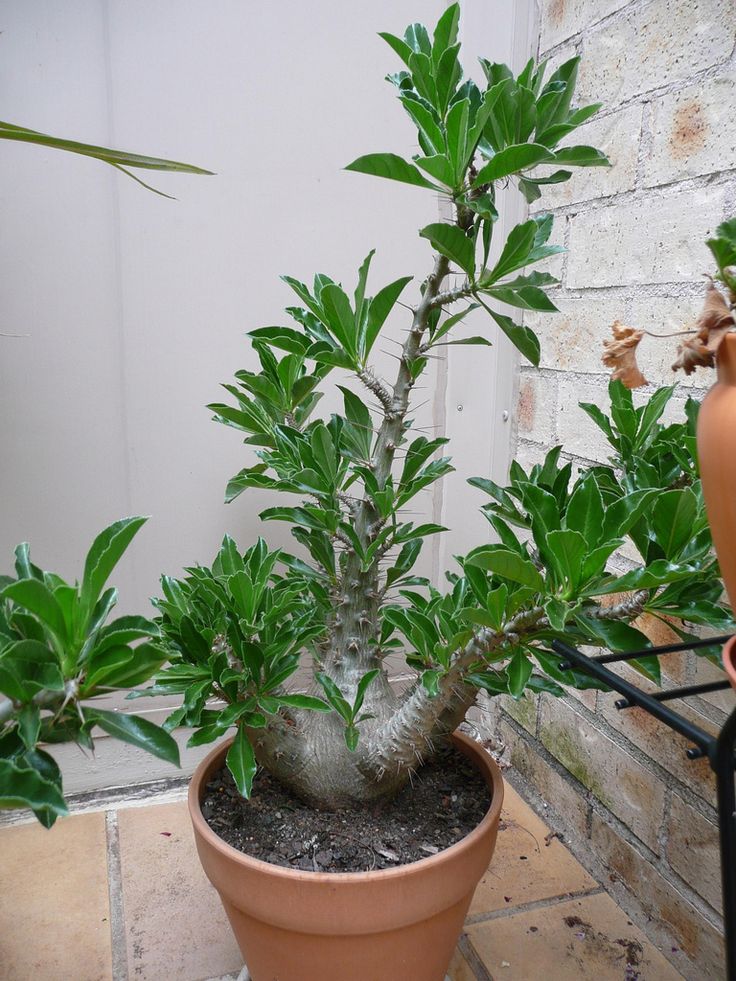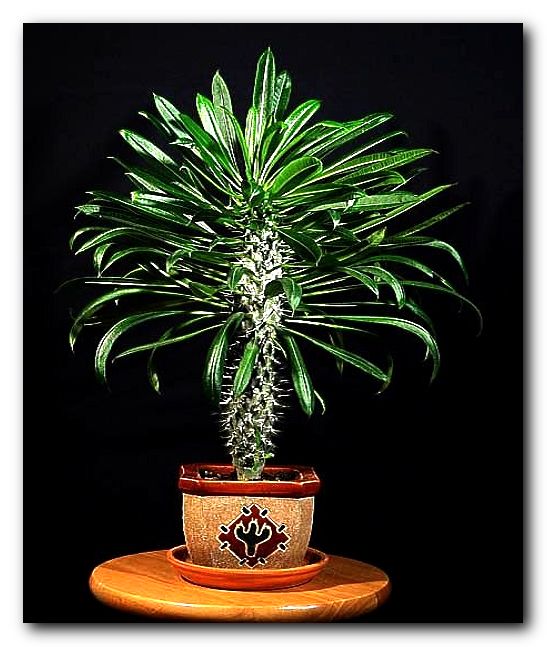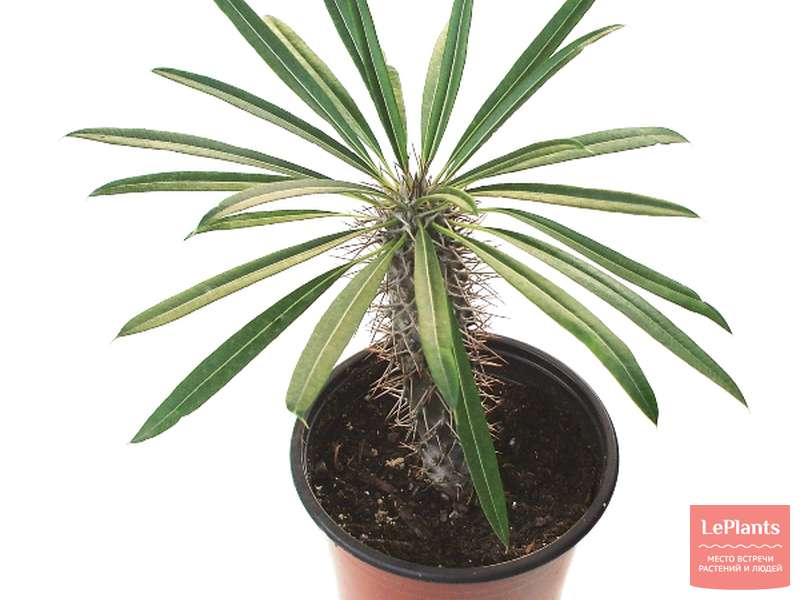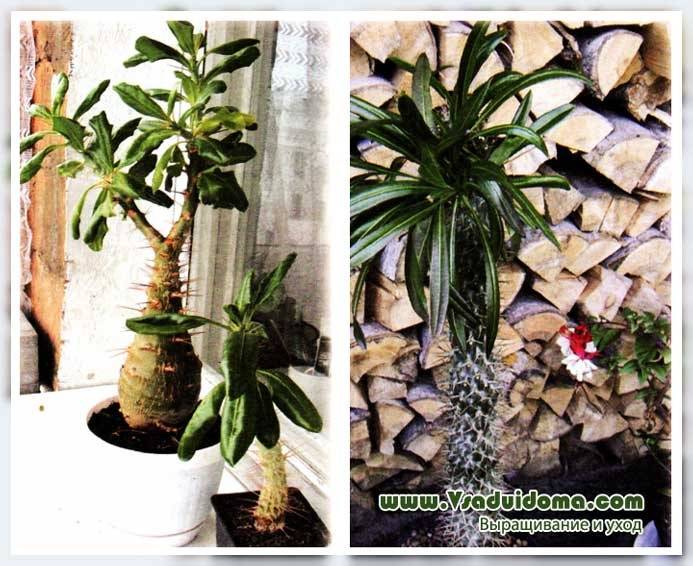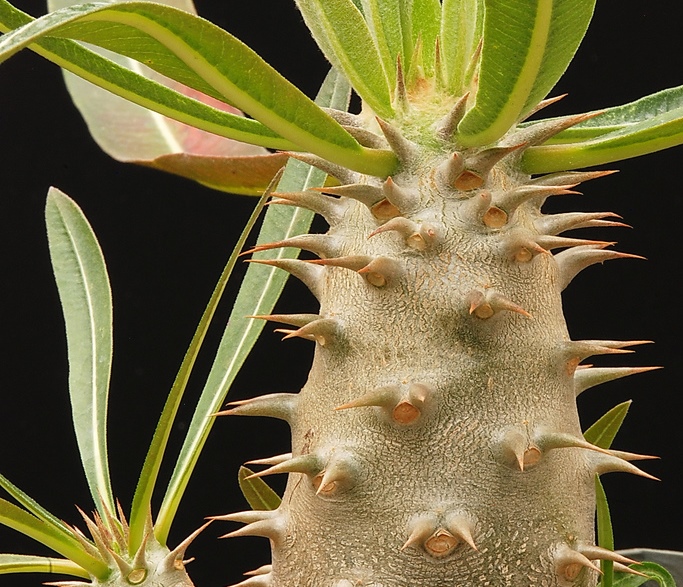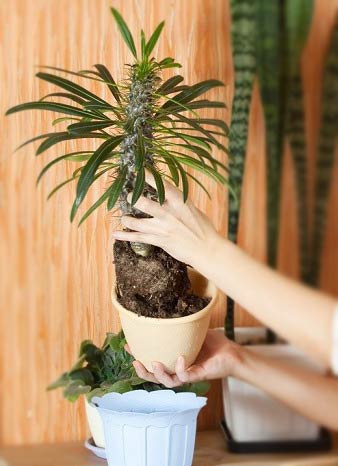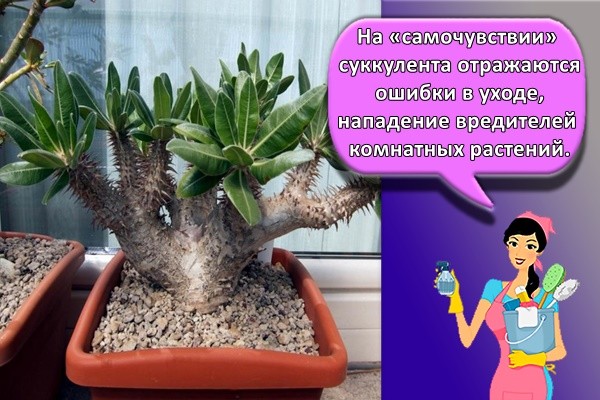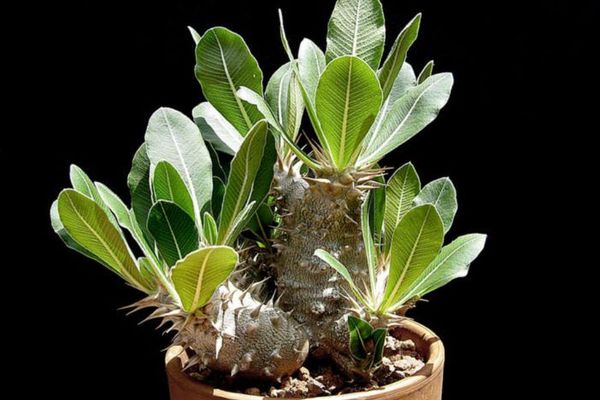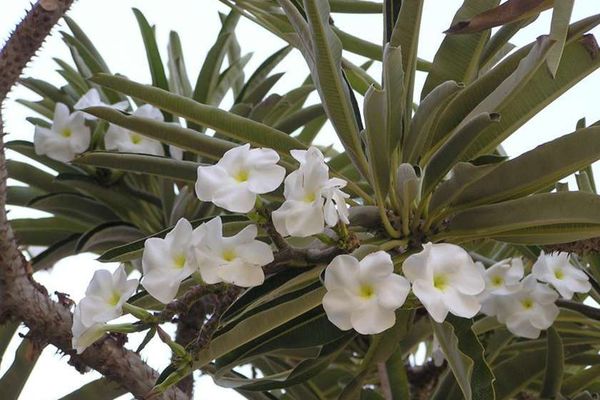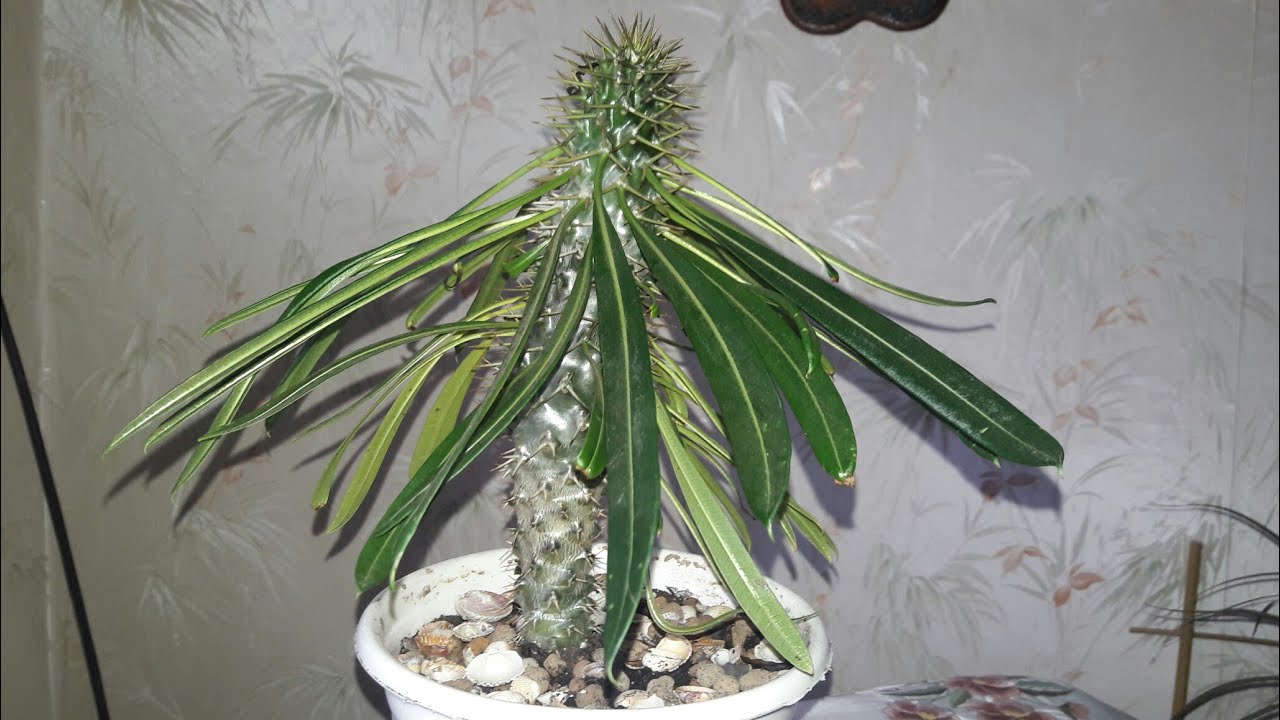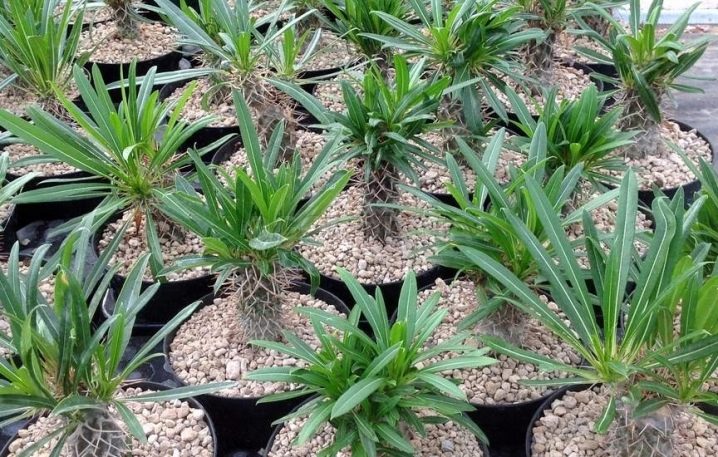Growing pachypodium from seeds
Despite the fact that the described plant is a succulent, it reproduces very poorly with apical cuttings.
If you want the pachypodium to appear before you form "babies" at the base, then for reproduction at home, it is recommended to use the seed method.
The best time
The best period for growing a plant from seeds is summer, as the air temperature will be at a sufficiently high level, which will contribute to better germination and normal development of seedlings.
Seed preparation
A feature of pachypodium seeds is a rapid loss of germination, therefore, in order to get a successful result in growing a plant, it is necessary to use fresh seeds.
Before sowing, the planting material must be soaked in warm water (up to +35 ° C), and kept for about three hours.
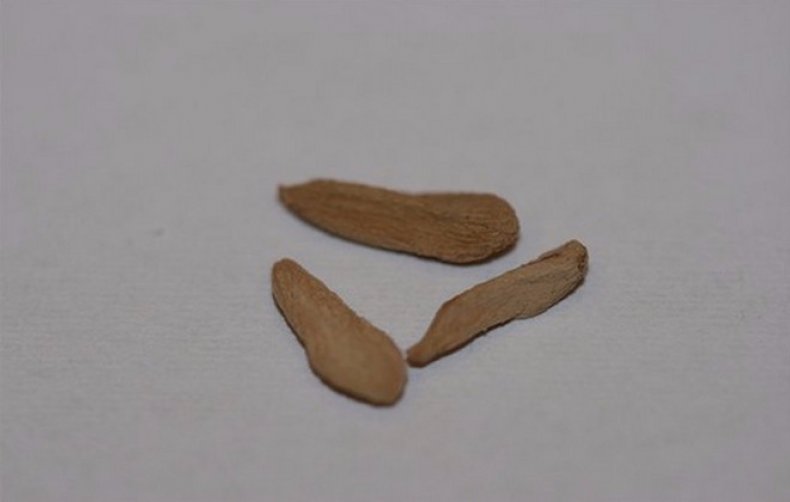
Sowing and caring for seedlings
To prepare a suitable soil for sowing seeds, it is necessary to use leaf humus - 1 part, charcoal - 1 part, sod soil - 0.5 part, vermiculite - 1 part, sand - 4 parts, bone meal - 10 g.
Soil is poured into the selected container and watered. At the same time, one can observe the subsidence of the substrate and the leveling of its surface. Next, you need to spread the seeds so that there is an interval of 3 cm between them and cover them with a five-centimeter layer of the substrate.
With a sprayer, you need to water the sowing. Next, the container should be placed in a transparent plastic bag.
Use a large needle to puncture the bag with a large needle to prevent condensation from forming.
Seedlings should be watered regularly, without waiting for the substrate to dry.
The air humidity should be at 80%, while the seedlings should be regularly ventilated, about 3 times a day.
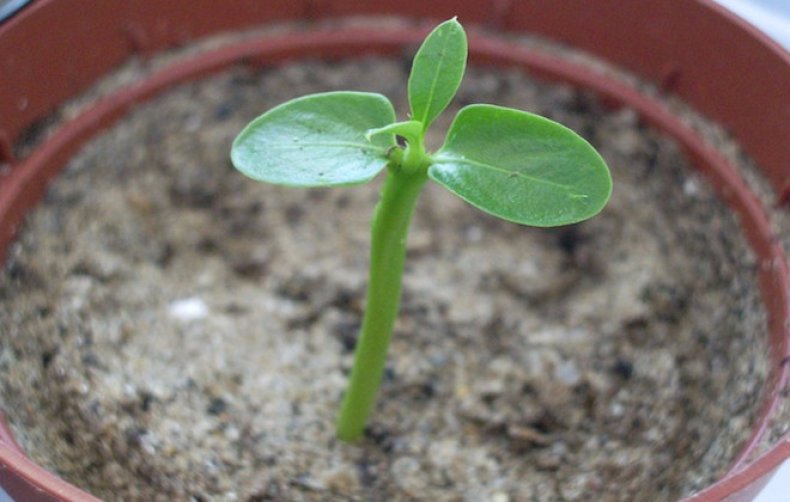
When the first shoots appear, the package should be removed completely.
The optimum temperature for keeping seedlings is +25 ° C and above.
The germination rate of seeds depends on the conditions of the crops and can range from 1 to 4 weeks.
If the seeds do not germinate in 6 weeks, then they are considered not viable.
After the seeds have germinated, the air humidity should be reduced to 60%.
Seedlings should be placed in direct sunlight before 11 pm and after 5 pm. The rest of the time, crops need diffused sunlight.
Did you know? The pachypodium appeared in Madagascar, from where it spread throughout the world, and the name "Madagascar palm" is associated with this fact.
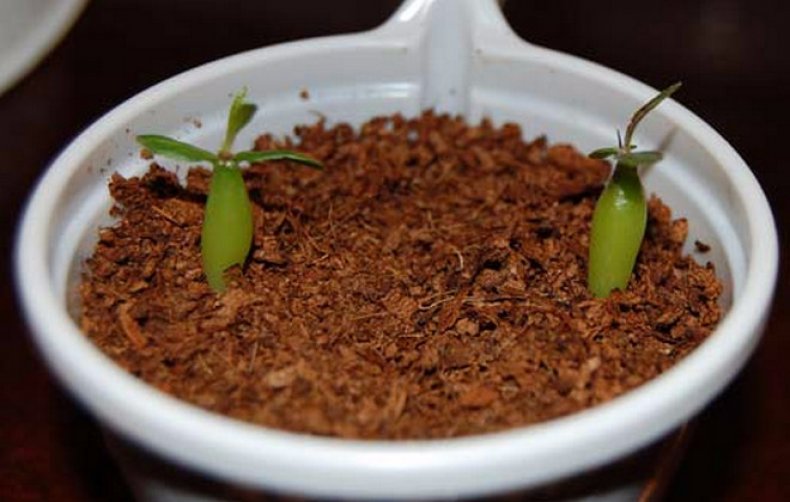
Types of pachypodium home
In the natural environment, there are more than 20 species of pachypodiums. Some of them have taken root well at home.
Pachypodium lamerei
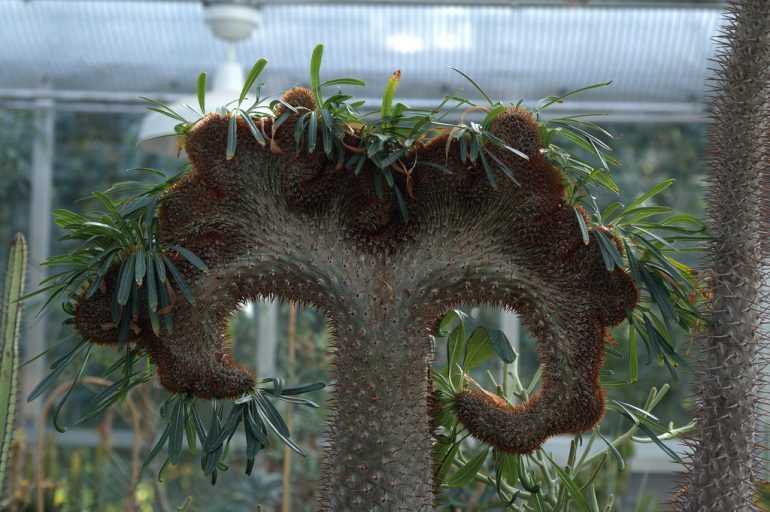
A tree with an erect thick stem, covered with large thorns. The lower part is thickened. Spiral-like thickenings run along the entire trunk. The top is decorated with a rosette of elongated lanceolate leaves attached to the base with long petioles. It blooms with large creamy flowers with a pale pink tint. The pharynx of flowers has a yellow tint.
Pachypodium geayi
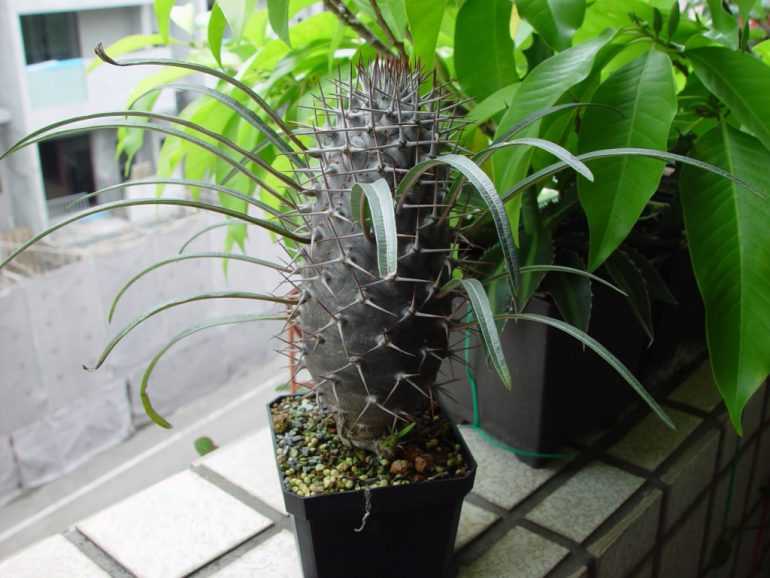
A tree with a thorny thick trunk. The spines are gray with a black tip. Dark green leaves with a vertical brown-red stripe in the center are covered with a delicate nap. The flowers are snow-white with a yellow spot in the center. The height of the tree is up to 0.5 m.
Pachypodium short-stemmed / Pachypodium brevicaule
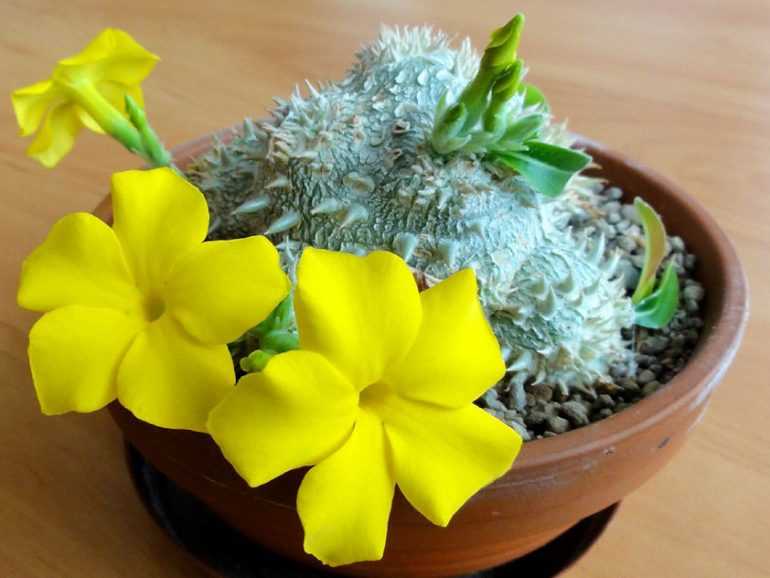
A thorny succulent tuberous stem, the diameter of which reaches 0.6 m. When leaves are absent, it merges in shape and color with the stones surrounding it. It blooms with yellow small elongated flowers.
Pachypodium saundersii / Pachypodium saundersii
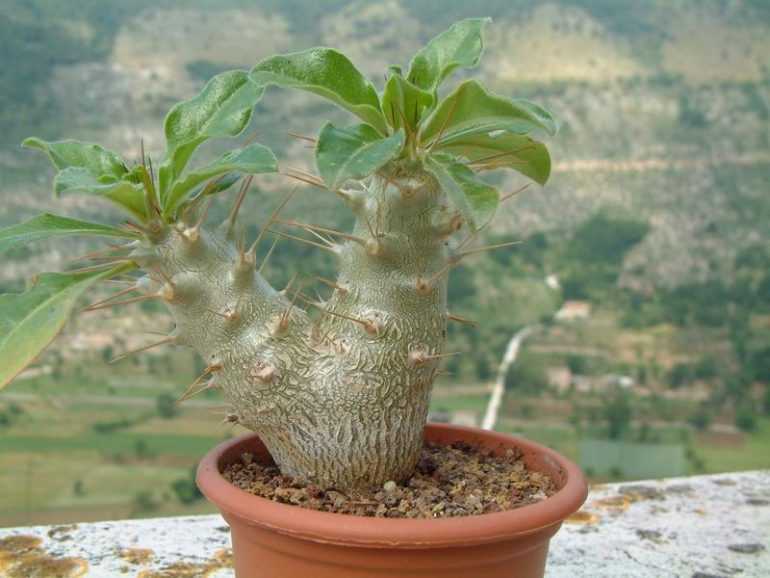
The height of the spherical stem reaches a little more than a meter. The spines are few. Leaves are lanceolate, wide with a slight taper at the end. It blooms luxuriantly with white flowers with lilac stripes.
Pachypodium succulentum Pachypodium succulentum
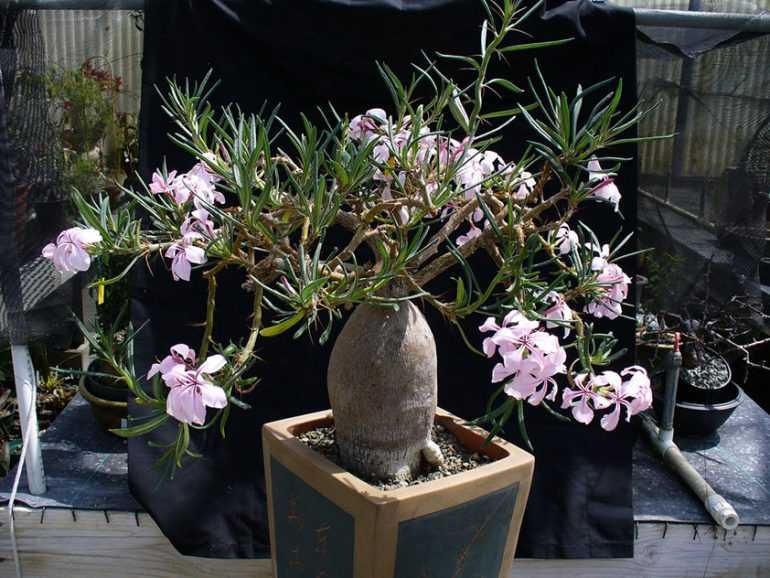
The height of the tree is up to 0.5 m. The diameter of the thickened lower part reaches 0.15 m. It has numerous lateral shoots, their length reaches 0.9 m. The shoots are covered with long spines and lanceolate pubescent leaves. It blooms in summer with pink flowers with a scarlet throat. The flowers are like bells.
A thorny tree with a powerful silvery stem stands firmly in a flowerpot. A graceful tuft at the top brings a playful touch to his look, while bright flowers add charm. Pachypodium is an original plant, disinterestedly giving the owner joy and a sense of security.
Conditions of detention
Despite the unpretentiousness of the varietal species of the pachypodium, the plant is sensitive to external conditions. The tree has a slow growth, if you do not follow the basic requirements for maintenance, it can dormant and stop development. It is recommended to provide good quality lighting, moderate humidity and choose the right place for growing.
Lighting
The pachypodium is a light-loving palm tree, with regular darkening, decorativeness decreases and growth slows down. The plant prefers continuous and diffused light, direct sunlight can lead to drying of the leaves and trunk. In the summer, it is possible to keep it on a glassed-in balcony or loggia, but it is advisable to bring the pot home at night. The tree is recommended to be placed on the east or west windowsill of the apartment.
Temperature and humidity
The plant has pronounced periods of dormancy and vegetation. Active growth is observed from spring to early autumn, during this time it is recommended to maintain the temperature in the range of 18-28 oC. In winter, when the palm is dormant, the heat should be lowered to 14-17 oC.

Like other succulents, the pachypodium can tolerate prolonged drought. The flower is unpretentious to humidity in the room, it feels comfortable in the apartment at any time of the year. To maintain the health and elasticity of the leaves, it is enough to observe the watering regime.
Soil and pot
For growing pachypodiums, a ready-made store-bought mixture for cacti and succulents will go. The main requirement for the soil is high friability and neutral acidity. The substrate can be prepared independently; for this, garden soil, coarse sand and peat are mixed in equal proportions. Additionally, it is recommended to add pieces of brick chips and clumps of clay.
There are no specific capacity requirements. Florists practice growing this crop in wide, low pots made of light-colored ceramics - it helps to maintain a stable soil temperature.
Pachypodium care reproduction description photo video watering lighting
The pachypodium is a succulent plant with a rather thick, fleshy stem and thin leaves at the top, forming a kind of crest. It belongs to the kutrov family and has about twenty species, the smallest of which fit in the palm of your hand, and the height of the large ones exceeds the height of a three-story house. As a potted plant, all Pachypodiums grow no more than seventy centimeters in height.
Natural habitat - Australia, Africa and Madagascar regions with an arid climate, where these plants feel so good that they amaze the imagination with their size and bizarre shape. There are many wild species of pachypodiums, only a few of them can be found in the apartments of amateurs.
Lighting. The pachypodium prefers bright direct sunlight, without shading, but it can grow in partial shade (in this case, the plant stretches and becomes less decorative).
South, south-west and south-east exposure windows are well suited for growing plants.In the summer, the pot with the plant can be exposed to fresh air, in a warm, brightly sunlit place, gradually accustoming to new lighting.
If there were few bright days in the autumn-winter period, then, in the spring, with an increase in illumination, it should be gradually accustomed to direct sunlight in order to avoid sunburn, and the acquired plant should also be dealt with.
Temperature
An important condition for growing a pachypodium is a sufficient air and soil temperature and the absence of drafts. In summer, the temperature can even be higher than 30 ° С, in winter - not lower than 16 ° С (for Lamer's pachypodium not lower than 8 ° С)
Window sills above radiators are well suited for a plant.
In the autumn and winter months, in a number of plants, the trunk can naturally become bare (leaf fall) and the tuft of leaves moves higher and higher along the trunk.
Watering. From March to October, the plants are watered abundantly, the earthen lump should always be slightly damp
Watered carefully - the pachypodium does not like excessive waterlogging of the soil, when overflowing, the roots and part of the stem can rot. Always watered with warm and well-settled water
Watering in winter is reduced, especially for species dropping leaves, for others, the earthen coma is not allowed to completely dry out.
From October to March, watering for plants that shed their leaves is very limited to avoid the death of the roots. When leaves fall, it is advised to stop watering for several weeks and resume it only after the appearance of new foliage.
Air humidity. Air humidity does not play a significant role. Pachypodiums normally tolerate dry air; it is not necessary to spray the plants (unless only to wash off the dust from the leaves).
Fertilizer. Top dressing in spring and summer once every two weeks with fertilizer for cacti. During the first month after transplanting, the plant is not fed. It must be remembered that in mineral fertilizers the level of nitrogen should be less than other elements, since an excess of nitrogen can provoke rotting of the roots, normally you can adhere to this ratio: nitrogen (N) - 9, phosphorus (P) - 18, potassium (K) - 24. It is better to refrain from using organic fertilizers.
It is advisable to add charcoal and brick chips to all substrates.
Good drainage is required (at least a third of the pot height).
The plant is suitable for hydroponic culture.
Reproduction. The pachypodium is propagated by seeds at temperatures above 20 ° C. Unlike many succulents, pieces of the pachypodium stem are difficult to root. However, you can try to root the upper part of the plant if the lower part is irreversibly rotted, after drying it and sprinkling it with charcoal.
Breeding by cuttings
The scheme is as follows: a stalk growing at the very top is cut off, sprinkle the cut with charcoal and immediately transplant the flower into a new vessel.
In order for the sprout to take root, we plant it in the same ground where the adult plant was.
The most viable sprouts are fifteen centimeters long.
For the cuttings, the same care is needed as for an adult "palm".
The sprouts are traditionally planted in the first spring months.
Seed breeding
From experienced gardeners, you can hear that cuttings do not always take root, even if the care was correct. Therefore, many tend to breed with seeds, which can be bought at any highly specialized store. Each seed is introduced into the soil by half a centimeter and is looked after like an adult plant.
If your gardening chores do not bring you much joy, you should think about purchasing a ready-made pachypodium in a pot. Its price will depend on the variety and height of the plant.
Reproduction of the pachypodium at home
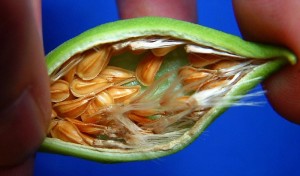
In the photo pachypodium seeds
In the wild, the trees and bushes of the pachhopodium reproduce by seeds, at home you can also try to grow a plant from seeds, but a novice florist may encounter an unforeseen difficulty: they germinate very slowly and are difficult to acquire. Guaranteed good seeds can be bought either in large specialized seed stores, or ordered by mail, but in this case there is no guarantee that they will sprout, since there is no guarantee that it will be exactly the pachypodium.
In order to grow a small tree from a seed, patience is needed.The seeds are planted in a small pot, the soil can be taken for cacti. Plant, water and cover with glass or foil on top, put in a sunny place. The sprout will appear quickly, in about a week, after which the film is removed, and the small pachypodium is grown in a sunny place, regularly watering. Interestingly, even a five-centimeter baby already has sharp thorns on the stem.
Lamers can be propagated by lateral processes; before planting, they are separated and dried for two or three days. After that, they are planted in the soil, but very often the shoots simply live on it for a month or two, without giving roots, then, when the supply of food ends, they die.
Folk omens and superstitions
The following signs and popular beliefs are associated with the Madagascar palm tree:
- palm trees accepted as a gift will bring grief to the family; in order to avoid misfortune in the house, it is necessary to buy off the flower with a coin;
- Madagascar palm transforms negative energy into positive;
- when the pachypodium begins to bloom, the house is filled with love and goodness;
- the flower will save its owners from unfriendly guests, they will feel tired;
- faithfulness will be maintained in the house in which this flower is located, all family members will draw closer;
- since the pachypodium belongs to the cactus family, it is impossible to keep it in the bedroom, because the flower can adversely affect human health;
- cacti and flowers of the cactus family contribute to the emergence of alcoholism in the family, and unmarried girls are doomed to the crown of celibacy;
- single women who collect succulents of different types can find themselves a man and marry successfully.
Whether to believe these signs and superstitions is everyone's personal business. But despite this, there are many couples who live happily growing pachypodium
The pachypodium is a fairly popular, albeit unsafe flower in everyday life, which requires sufficient care, as well as precautions. Knowing the signs and superstitions and believing in them, you can prevent problems in the family.
Was this helpful?
Thank you for your opinion!
You can recommend the article to your friends!
You can recommend the article to your friends!
Yes
No
Breeding methods of the Madagascar palm
It is not difficult to grow your exotic tree from scratch; for this you can use seed material or resort to the cuttings method. Each of the methods is effective, the main thing is to follow the basic rules:
Sowing seeds and caring for seedlings
In its natural environment, the pachypodium reproduces exclusively by seeds. To harvest material from a houseplant, secure the ripening, light brown pods with tape or yarn. This ensures that the fruits will not split when the time comes to release their contents.
Before planting, a special soil substrate should be prepared: for 4 parts of coarse washed sand, 1 part of well-rotted organic matter - compost, the same amount of perlite and vermiculite is taken. The mixture should be sterilized before use.
Seeds are sown in the summer, deepening by 5–6 mm, the depth should not exceed 10 mm. The distance between the seeds is 3-4 cm.
Place the container in a warm, dry place. The optimum air temperature is considered, which varies from 27 to 35 degrees. Seeds that have not hatched after 1.5 months are not viable.
Sprouts with 3-4 leaves are ready for transplanting into separate pots, drainage is required.
Rooting stems and cuttings
For reproduction of the pachypodium in similar ways, you can use parts of the stem and root cuttings:
10–12 cm pieces of young, healthy twigs are cut off; it is better to do this in the spring, in May.
The cut sites are washed under running water to remove the secreted milky juice.
Then the segments should be dried in the open air until a crust forms in the place of the cut.You can treat the ends of the cutting with a preparation that stimulates root formation.
For rooting, a substrate with a light, air and waterproof consistency is used; sand is also suitable for this purpose.
It is recommended to moisten the soil from time to time, you can irrigate from a spray bottle
It is important to exclude excess moisture and its stagnation.
Cuttings do not immediately give roots, so the florist needs to be patient. It is possible to grow a new plant from a part of the root, but this method is used very rarely.
Most often, pachypodiums are grown from seeds, but vegetative methods are often the only way to save an ailing, rotten flower.

Reproduction of the pachypodium
Reproduction of the pachypodium is carried out using seeds or cuttings.
Propagation of the pachypodium by cuttings
If the trunk of the cactus has begun to rot, the pachypodium is propagated by cuttings. The method makes it possible to save the pachypodium. A healthy fragment is cut with a sharp knife. The cut site is blotted with a napkin and sprinkled with charcoal powder. Dry for some time until a protective film appears. Then they are planted in a substrate or sand. They are kept at + 26 ° C, sometimes watered.
Growing pachypodium from seeds
The main option for obtaining a new cactus. Seeds are soaked in a warm solution of potassium permanganate before planting. After 2 hours, they are sown into the soil at a distance of 40 mm from each other, deepening by 10 mm. Cover with foil. Seedlings are aired daily, rarely watered - when the substrate dries up. When seedlings appear, the film is removed. When the first 2 leaves appear, the seedlings dive into separate containers.
Getting a new pachypodium is a long process. Especially a lot of time is spent on rooting cuttings.
It is important to maintain moderation in watering so that the base of the trunk does not rot.
Diseases and pests
Most of the problems of the Pachypodium (Madagascar palm) are due to poor quality care:
- 1If improper watering, a sharp decrease in temperature, a change in "place of residence", the plant throws off the foliage.
- 2 With an excess of moisture in the ground and air, various kinds of rot can develop (on the root system, trunk, foliage).
- 3In a draft, the foliage turns black, withers and falls off.
The palm tree is susceptible to attack by spider mites, thrips and scale insects. Due to the high thorniness of the trunk, it is quite difficult to cope with insects with your own hands, therefore it is better to spray the Pachypodium with special agents, for example, Aktellik or Fitoverm.
Flowers affected by a tick are distinguished by pale and yellow foliage. White specks can be seen on top of the leaf. Foliage flies ahead of time. Rusty spots can be seen between the thorns on the trunk.
Dry air in the room contributes to the appearance of red mites. Pest control measures are simple. Spraying should be carried out with the following means:
- 1Derris.
- 2Fitoverm.
- 3Fufan.
- 4Atellik.
In addition to the tick, the flower can infect thrips. It is provoked by an incorrect temperature regime and a low level of moisture. A sign of thrips is the appearance of many colonies below the leaf, and white dots above. As a result, the top of the leaf changes color to gray-brownish with a silvery sheen. You can destroy thrips. The Madagascar palm must be sprayed with insecticides:
- 2Fitoverm.
- 2Decis.
- 4Atellik.
- 4 Inta-vir.
The fact that the plant is sick is most often indicated by black, slightly stained foliage. This is usually caused by excessively cold temperatures in winter and too frequent watering. If the plant is transferred to a dry and warm place, it will recover without the unnecessary help of a grower.

The pachypodium is very susceptible to decay, so you need to monitor the watering regime, it should not be poured and overdried. Care must be taken to keep the ground moist. With proper care, the stem will have a beautiful shape, it will not become crooked and thin.
Care
Lighting.The pachypodium prefers bright direct sunlight, without shading, but it can grow in partial shade (in this case, the plant stretches and becomes less decorative).
South, south-west and south-east exposure windows are well suited for growing plants. In the summer, the pot with the plant can be exposed to fresh air, in a warm, brightly sunlit place, gradually accustoming to new lighting.
If there were few bright days in the autumn-winter period, then, in the spring, with an increase in illumination, it should be gradually accustomed to direct sunlight in order to avoid sunburn, and the acquired plant should also be dealt with.
Temperature
An important condition for growing a pachypodium is a sufficient air and soil temperature and the absence of drafts. In summer, the temperature can even be higher than 30 ° С, in winter - not lower than 16 ° С (for Lamer's pachypodium not lower than 8 ° С)
Window sills above radiators are well suited for a plant.
In the autumn and winter months, in a number of plants, the trunk can naturally become bare (leaf fall) and the tuft of leaves moves higher and higher along the trunk.
Watering. From March to October, the plants are watered abundantly, the earthen lump should always be slightly damp
Watered carefully - the pachypodium does not like excessive waterlogging of the soil, when overflowing, the roots and part of the stem can rot. Always watered with warm and well-settled water
Watering in winter is reduced, especially for species dropping leaves, for others, the earthen coma is not allowed to completely dry out.
From October to March, watering for plants that shed their leaves is very limited to avoid the death of the roots. When leaves fall, it is advised to stop watering for several weeks and resume it only after the appearance of new foliage.
Air humidity. Air humidity does not play a significant role. Pachypodiums normally tolerate dry air; it is not necessary to spray the plants (unless only to wash off the dust from the leaves).
Fertilizer. Top dressing in spring and summer once every two weeks with fertilizer for cacti. During the first month after transplanting, the plant is not fed. It must be remembered that in mineral fertilizers the level of nitrogen should be less than other elements, since an excess of nitrogen can provoke rotting of the roots, normally you can adhere to this ratio: nitrogen (N) - 9, phosphorus (P) - 18, potassium (K) - 24. It is better to refrain from using organic fertilizers.
Transfer. Overgrown plants are transplanted no more than once every two to three years, young annually. When transplanting, you need to carefully handle the roots - they are very delicate in the pachypodium. A permeable and nutritious substrate of peat with sand and a small amount of turf soil (pH 5-7) is suitable for replanting. Although in their homeland pachypodiums often grow on limestone, in culture they succeed in moderately acidic substrates, which can be made up of equal parts of sod and leafy soil with the addition of coarse sand. You can use a ready-made cactus substrate.
It is advisable to add charcoal and brick chips to all substrates.
Good drainage is required (at least a third of the pot height).
The plant is suitable for hydroponic culture.
Reproduction. The pachypodium is propagated by seeds at temperatures above 20 ° C. Unlike many succulents, pieces of the pachypodium stem are difficult to root. However, you can try to root the upper part of the plant if the lower part is irreversibly rotted, after drying it and sprinkling it with charcoal.
Breeding by cuttings
The scheme is as follows: a stalk growing at the very top is cut off, sprinkle the cut with charcoal and immediately transplant the flower into a new vessel.
In order for the sprout to take root, we plant it in the same ground where the adult plant was.
The most viable sprouts are fifteen centimeters long.
For the cuttings, the same care is needed as for an adult "palm".
The sprouts are traditionally planted in the first spring months.
Seed breeding
From experienced gardeners, you can hear that cuttings do not always take root, even if the care was correct. Therefore, many are inclined to breed with seeds, which can be bought at any highly specialized store. Each seed is introduced into the soil by half a centimeter and is looked after like an adult plant.
If your gardening chores do not bring you much joy, you should think about purchasing a "ready-made" pachypodium in a pot. Its price will depend on the variety and height of the plant.

